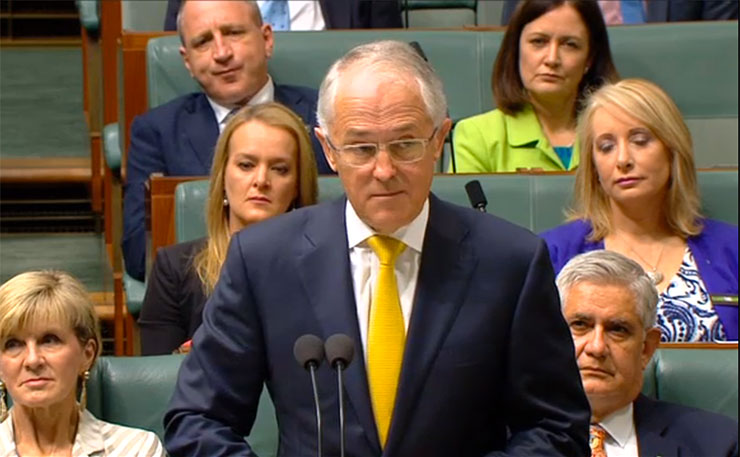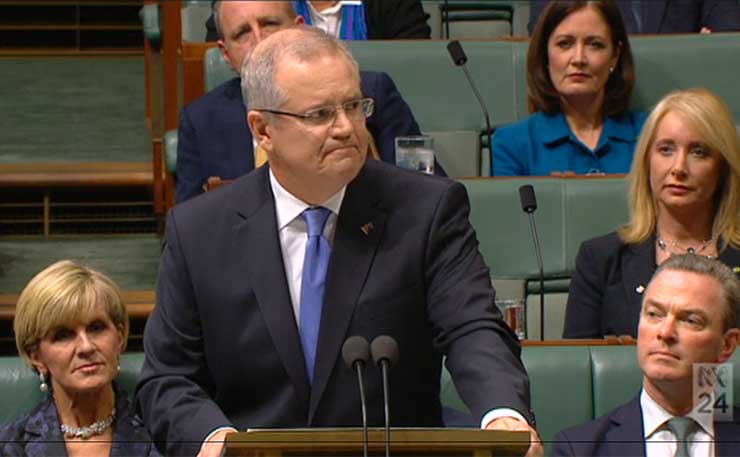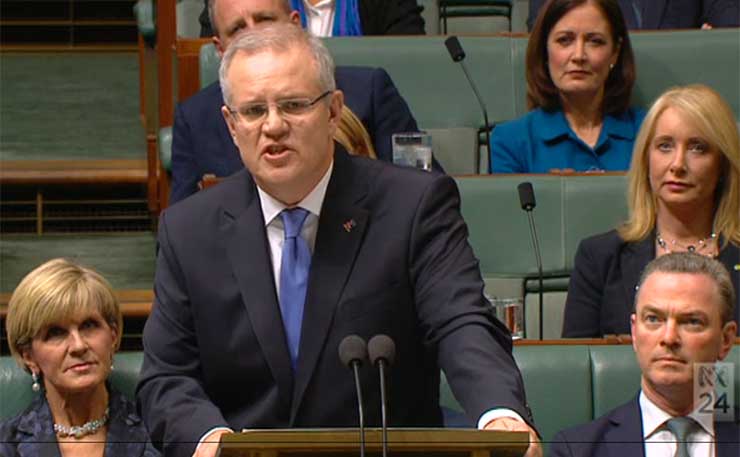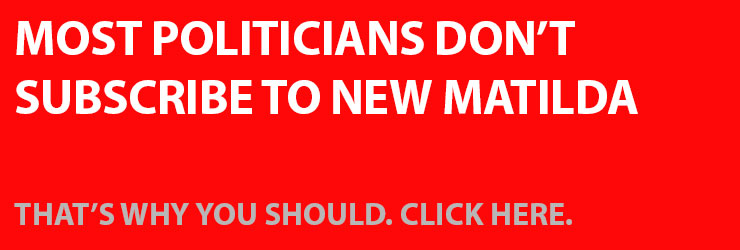BUDGET 2016: As the Treasurer handed down his first budget he wanted to talk about jobs. But with a gap in infrastructure funding and the economic headwinds blowing, there’s little reason to believe he’s got it right. Doing nothing might be the last thing ScoMo does as Treasurer, writes Ben Eltham.
After eight months of an under-performing Turnbull government, the dominant narrative has been disappointment.
The disappointment is partly about what Malcolm Turnbull promised: a saner, more mature, more consultative style of government. But its mainly about what Turnbull has delivered: a confused and disorganised government, that is none-the-less still surprisingly beholden to the conservative policies of Tony Abbott that voters rejected.
In part, this disappointment was understandable. All honeymoons must end, and popular leaders can lose their shine when forced to make hard decisions. But the bewildering thing about the Turnbull administration has been how few hard decisions it has actually made. Turnbull promised excitement, but he has delivered timidity. He promised agility, but he has delivered stasis.
And so it is with this budget – Scott Morrison’s first, and quite possibly his last.
The tasks faced by Morrison crafting this budget were many and varied. He had to frame a statement that could steer the ship of state in uneasy seas, as the Australian economy continues to rebalance after the end of a once-in-a-generation mining boom. He had to consolidate the Coalition’s claims to better economic management, while building up a war chest for election promises. Perhaps most importantly, he needed to bed down voter perceptions of the legitimacy of the Turnbull administration, despite the disappointment many feel.
Worryingly for the Coalition, this budget does none of those things. It comprehensively fails to establish a convincing economic narrative. It does nothing to assuage fears that Morrison is out of his depth. It doesn’t make any great dent in the budget deficit, but nor does it invest heavily in the future prosperity of the nation.
This is a budget in a holding pattern. The best that can be said is that it muddles through.
Much of the budget coverage will be about the upstaging of Morrison’s statement tonight by the interest cut from the Reserve Bank this afternoon. This appears to have blindsided the government – Morrison didn’t even mention it in his media conference.
But it shouldn’t have surprised. Certainly, the sudden weakness of the big banks’ balance sheets and the shock deflation in consumer prices last quarter seems to have worried many in the financial markets.

The Reserve Bank is clearly troubled about an anaemic economy, with low wages growth and inflation bumping along at close to zero. As Glenn Stevens wrote in his policy statement today, “prospects for sustainable growth in the economy, with inflation returning to target over time, would be improved by easing monetary policy.”
Such caution was a far cry from the bullish perspective presented by Scott Morrison this evening. In his media conference, he hammered home the government’s preferred mantra of “jobs and growth”, claiming that this was a budget that was a “National Plan” for the next decade. “We’ve investing in growth,” he insisted.
The budget papers tell a different story.
Capital investment remains remarkably low, particularly outside of defence. Embarrassingly, the government has not even been able to spend all of its much-vaunted ‘Asset Recycling Fund’, which itself was merely spending the proceeds of asset sales anyway. And while there are some big dollars allocated to defence spending in the coming decade, defence spending has less of the positive spill-over provided by capital investment in urban public transport, ports or roads.
Yes, there are tax cuts – but again, they won’t add up to much economically because they are targeted almost exclusively at the rich. The increase in the $80,000 tax bracket to $87,000 will help only the top quarter of income earners, while the cuts to company tax will be marginally stimulatory, at best.
Morrison was at pains to portray his company tax cuts as a boost for jobs. Unfortunately, there is surprisingly little economic evidence to support the idea that cutting tax rates for companies translates into higher economic growth. The reasons are not that hard to understand: companies can simply pocket the difference in higher profits. For domestic companies, some of these profits eventually return to the economy in the form of dividends. But overseas corporations can take the money and run.
So, on balance, there is little in this statement that will boost economic growth in the short-term. The budget seems to have been prepared on the basis that little more than current settings are required. While it is still a deficit budget, it was a deficit last year and the year before. What matters in macroeconomic terms is the change in government spending, and in this respect the government is spending slightly less.
Instead, this budget charts a course of steady fiscal consolidation in the medium term, with a budget surplus to materialise sometime around 2021 as a result of revenue growth from an economy returning to trend growth.
And once again, we would be wise to cast a sceptical eye over Treasury’s forecasts. Ever since the global financial crisis punched a huge hole in federal revenue in 2010, successive treasurers have been claiming that the return of the economy to robust growth would fix the budget. Time and again, Wayne Swan and Joe Hockey promised that a return to trend growth would see the budget return to surplus. Time and again they were proved wrong. Morrison’s budget deficit this year is larger than the deficit presented by Chris Bowen in 2013.
Of course, the glass could be half full, not half empty. It may be that in the coming year, the economy does move up a gear. If GDP started growing strongly – above 3 per cent would be nice – then unemployment would indeed fall and tax revenue would start flooding back into the Treasury.
But there is no sign of that in an economy that is only sluggishly responding to record low rates of interest, as Glenn Stevens acknowledged today. Conditions seem uncertain, perhaps subdued. Could this be the beginning of the dreaded “secular stagnation” that has so flummoxed economists in the United States and Europe? Only time will tell.

Long before we find out the direction to the economy’s growth path, the government will have to call an election. Given tonight’s lacklustre budget, it could be a close-run thing.
In his media conference, Morrison argued that ordinary Australians had moved on from the old narrative of “winners and losers.” That may well be wishful thinking, because there are plenty of losers from this budget (and not just smokers).
Health and education both suffer.
After the multi-billion dollar cuts of 2014, the health sector is already hostile. By keeping the pause to Medicare indexation, the Coalition has guaranteed an angry reaction from the Australian Medical Association. There are also significant cuts to aged care, affecting a key Coalition constituency. Public hospitals get just $2.9 billion, which also translates to a funding cut, when compared to the funding trajectory promised to hospitals by Labor when it left office.
Universities will be outraged at the government’s double-cross over fee deregulation: the government has abandoned its goal of raising student fees, but will still cut $1.5 billion from university funding. Schools get a paltry $1.2 billion, which is much less than the “full Gonski”, and with onerous conditions attached.
And yet despite antagonising some rather noisy opponents, the government has favoured few winners. Taxpayers earning more than $80,000 get a small tax cut that many will hardly notice. Small business gets a tax cut that, by definition, can only help those already making a profit.
Big multinationals are likely to be happiest, after receiving their cherished tax cut in company tax. But big corporations don’t vote. Many in the community may decide that big companies are being rewarded at their expense.
The superannuation changes are a small step towards equity, at least. The government has cracked down on some of the worst excesses of our absurdly generous superannuation tax concessions, gaining about $6 billion in revenue over the forward estimates by winding back tax breaks for the top 1 per cent of superannuants. Some of that revenue is then reinvested into supporting low-income superannuants, for instance by reintroducing the Low Income Superannuation Tax Offset, which ensures low-income earners pay no tax on their super contributions.
But there were few such measures for the middle class. Middle-income earners received little joy in this budget, even as corporations won big tax reductions.
As the old saying goes, a budget is a political document, not an economic one. On that analysis, Morrison and Turnbull are in serious trouble. Reaction to this budget is unlikely to be positive. With the election due to be called later this week, the political environment for the Coalition could quickly deteriorate.
Donate To New Matilda
New Matilda is a small, independent media outlet. We survive through reader contributions, and never losing a lawsuit. If you got something from this article, giving something back helps us to continue speaking truth to power. Every little bit counts.





